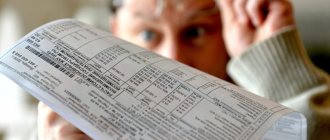Pravozhil.com > Housing and communal services issues > Utilities > Housing and communal services receipts > Does the number of registered ones affect the rent, how are payments calculated?
When calculating the amount of utility bills, not only the size of the living space is taken into account, but also how many citizens are registered in it
Does the number of people registered affect the rent? It's no secret that payments for utility services are calculated based on the square footage of the property and the number of registered people.
However, some services are charged based on the parameters of individual meters. Owners install these devices in apartments at their own expense.
Lately, this has been a fairly common way to save money for owners who have many people living in their apartments.
It is important to understand that the responsibility to regularly pay utility bills rests with the property owner. In exceptional cases, obligations, through contracts, are assigned to the tenants.
Does the number of people registered affect the rent? Let's take a closer look.
Calculation of the population of residential buildings
Contents
1. Analysis of the architectural and planning situation 4
1.1 Type of territory development 4
1.2 Area and density of buildings 4
1.3 Calculation of the number of residential buildings 5
1.4 Landscape architecture objects 8
1.5 Insolation regime of territory 9
2. State of landscaping. Inventory of plantings. Improvement project 11
References 18
A clean, landscaped yard with a good road and a modern playground plays an important role in creating a comfortable living environment. After all, this is where your beloved home begins - with a yard in which you can relax, walk with your children and play sports.
In all developed cities of the world, the improvement of public natural and recreational areas and courtyard spaces of multi-apartment residential buildings is the subject of special attention from official authorities at all levels, social movements, the media and the general population. This process is inextricably linked with urban planning and is a kind of mirror reflecting the level of social and economic well-being in the country, which is why many world capitals strive to constantly improve the living conditions of their citizens.
1. Analysis of the architectural and planning situation
Type of territory development
Building area and density
Methodological justification. In this section of the explanatory note it is necessary to indicate the area of the building as a whole and separately the area of each building. The construction area includes the area of all residential and non-residential buildings and structures. The percentage of the development area from the area of the entire design area (the entire facility) is an indicator of the development density. The area of buildings and structures is indicated in accordance with their postal address.
Purpose of the work: to determine the building area and building density in the designed area.
Work progress:
1. mark on the topoplan (M 1:10) the boundaries of the designed territory and determine its area (S design territory, m 2);
2. find all buildings and structures on the topoplan. Determine their purpose;
3. determine the area of each building and structure (m2) and enter it into the table in accordance with the postal address;
4. summing up the areas of buildings and structures, determine the building area (S built, m 2);
5. find the percentage of the building area from the area of the entire designed territory, i.e. determine the building density.
| Objects | Area, m2 |
| Projected area | |
| Buildings and constructions: | |
| Residential building, st. Krasnaya, 23 | |
| Residential building, st. Red, 24 | |
| Residential building, st. Krasnaya, 25 | |
| Residential building, st. Red, 26 | |
| Household the buildings |
Calculation of the population of residential buildings
Methodological justification. When designing urban architectural objects, information is needed on the number of residents, on the number of residents of different ages. This information is taken into account when selecting improvement objects and establishing their sizes; on the basis of this information, zoning of territories is carried out. Information about the standards and requirements of various improvement facilities, depending on the number of residents and age composition, are reflected in special regulatory documents: SNiP 2.07.01-89 “Urban planning. Planning and development of urban and rural settlements”; SP 30-102-99 “Planning and development of low-rise housing construction areas.”
Purpose of the work: to become familiar with methods for calculating the number and age composition of the population in an urban area. Work progress:
1 part. Calculation of population.
When calculating the population, 2 methods can be used:
1. Calculation according to the social norm,
m 2
/person
Calculation of the population according to the social norm of 18 m2 per 1 resident:
– according to the plan, determine the area of the residential building, m2;
– determine the area of apartments in the building, taking into account its number of storeys:
S building* Σ floors = S sq. building, m 2 ;
S sq. building No. 23, m 2 = 705 * 3 = 2115 m 2 ;
S sq. building No. 24, m 2 = 705 * 3 = 2115 m 2 ;
S sq. building No. 25, m 2 = 900 * 3 = 2700 m 2 ;
S sq. building No. 26, m 2 = 900 * 3 = 2700 m 2 ;
- determine the number of inhabitants of this house:
S sq. building, m 2 : 18 m 2 = Σ inhabitants;
Σ residents of house No. 23 = 2115:18 = 118 people. ;
Σ residents of house No. 24 = 2115:18 = 118 people. ;
Σ residents of house No. 25 = 2700:18 = 150 people. ;
Σ residents of house No. 26 = 2700:18 = 150 people. ;
2. Calculation based on the average number of people living in a conditional apartment.
Data on the number of population are determined depending on the series of the residential building and the number of apartments in it. On average, 3-4 people are hired for a nominal apartment.
The conditional number of inhabitants in one according to this method is determined by the formula:
Σ live = Σ fl. *Σ under. *Σ sq.fl. *Σ avg.q., where
Σ live No. 23 = 3*3*3*4 = 108 people. ;
Σ live No. 24 = 3*3*3*4 = 108 people. ;
Σ live No. 25 = 3*3*4*4 = 144 people. ;
Σ live No. 26 = 3*3*4*4 = 144 people. ;
Σ live – number of inhabitants;
Σ fl. – number of storeys;
Σ under. – number of entrances in the house;
Σ sq.fl. – number of apartments on the floor;
Σ avg.q. − average number of residents in 1 apartment.
In this case, the number of residents according to the conditional social norm is assumed to be:
— 3 people for a one-room apartment;
— 4 people for a two-room apartment;
— 5 people for a three-room apartment.
Part 2 . Calculation of the approximate age structure of the population.
There is a conditional calculation of people of different ages as a percentage of the total population:
– preschool children under 6 years of age (preschoolers attending kindergartens and nurseries) – 4%;
walls on the loggia finishing finishing options
– children from 7 to 14 years old (schoolchildren in grades 1–8) – 11%;
– teenagers from 15 to 17 years old (high school students, students of secondary vocational education, technical schools, colleges) – 5%;
– pensioners (men over 60 years old and women over 55 years old) – 18%;
– working population (men from 18 to 60 years old, women from 18 to 55 years old) – 62%.
Source
Average Number of People Living in an Apartment
If the provider of public services has information about the presence of citizens living in a residential building that is not equipped with metering devices for consumed resources, without registration, he has the right to draw up an act establishing the number of citizens temporarily living in the residential premises. The drawn up act, within 3 days after its preparation, is sent to the authorized body in the field of migration, which conducts an inspection and, upon confirmation of the fact of citizens living in the premises without registration, draws up an act of administrative offense. It is this act that is the basis for determining the number of temporary residents in residential premises for the purpose of determining the amount of payment for utility services.
In addition, it is clarified that the use in calculating fees for utilities and/or maintenance of residential premises of such an indicator as the number of citizens indicated in the documents that are the basis for moving into residential premises and using residential premises (number of owners, number of tenants) is not acceptable.
Payment obligations
Responsibility for late payment of utilities rests entirely with the apartment owners
All service providers enter into contracts with the housing company or the owners themselves.
Based on the concluded document, it is the owner of the apartment who is responsible for non-payment of utility bills. This is regulated by Art. 153 of the Residential Code.
That is why every property owner must ensure that all service providers receive timely payments.
There are three options to force people registered in the apartment to pay for services:
- Personal accounts section. It is suitable if the question concerns relatives.
- Threaten to end your registration.
- Submit a claim to the court.
The last two methods are suitable for dealing with tenants. The property owner has the right to unilaterally terminate the contract at any time for failure to pay utility bills.
When going to court, the judge will order the tenants to pay the utility debt if the owner provides evidence of lack of payments.
To do this, you need to pay it yourself on your own behalf. Thus, it will be clear that the owner himself was forced to pay for utilities.
The payment is always generated and addressed to the owner of the apartment. Can be made for several persons.
Utility debt can be recovered using:
- sanctions;
- failure to provide services;
- lawsuit;
- eviction.
From the listed punishments, it is clear that there are enough methods to scare defaulters. The worst way is to lose your living space.
There are many ways to force landlords to pay their utility bills on time.
But it may be easy to avoid such a situation.
For tenants of a social apartment, it is enough not to pay for it for six months to find themselves in worse conditions, for example, in a communal apartment.
Calculation of the population of residential buildings
In all developed cities of the world, the improvement of public natural and recreational areas and courtyard spaces of multi-apartment residential buildings is the subject of special attention from official authorities at all levels, social movements, the media and the general population. This process is inextricably linked with urban planning and is a kind of mirror reflecting the level of social and economic well-being in the country, which is why many world capitals strive to constantly improve the living conditions of their citizens.
Methodological justification. In this section of the explanatory note it is necessary to indicate the area of the building as a whole and separately the area of each building. The construction area includes the area of all residential and non-residential buildings and structures. The percentage of the development area from the area of the entire design area (the entire facility) is an indicator of the development density. The area of buildings and structures is indicated in accordance with their postal address.
If the consumer refuses to sign such an act, then the act establishing the number of citizens temporarily residing in the residential premises is signed by the contractor, at least 2 consumers, as well as a member of the house council (if a HOA or cooperative has not been created), or the chairman of the HOA or cooperative, if management of the apartment building is carried out by a partnership or cooperative and the management body of such a partnership or cooperative has concluded a management agreement with the management organization.
- the end of the period of residence of such consumers in the residential premises, which is indicated in the application of the owner or permanently residing consumer for the use of residential premises by temporarily residing consumers, but not earlier than the date of receipt of such an application by the contractor.
Obligation to pay utility bills
Utility services are provided by specialized organizations to residential and commercial premises in order to ensure comfortable living conditions for people living in them. They are divided into:
- Hot and cold water supply.
- Electricity supply.
- Gas supply.
- Heating.
This type of service is paid and is provided in accordance with established tariffs. A written agreement is concluded between the service provider and the consumer, which establishes the rules of cooperation. The supplier is obliged to uninterruptedly supply the consumer with the required type of service. And the buyer must pay them on time and in full. Failure to comply with the established rules by one of the parties entails administrative punishment in the form of a fine, and possibly temporary disconnection from the source of consumption.
Legislative framework
The parties to the agreement on the supply and consumption of services are obliged to focus, first of all, on the legislative standards in force in the territory of the Russian Federation. The utility sector is regulated by the following regulations:
- Housing Code of the Russian Federation. The obligation to pay for the service provided is established in Article 153 of Section 7.
- Law No. 2300-1 of February 7, 1992 “On the Protection of Consumer Rights”.
- By Decree of the Government of the Russian Federation No. 354 of May 6, 2011, which adopted the “Rules for the provision of utility services...”.
According to the Housing Code of the Russian Federation, the responsibility for making payments for consumed resources rests with:
- Tenants who will live in the premises on the basis of a signed social rental agreement.
- Tenants of state and municipal housing.
- Tenants of municipal and state apartments and houses.
- Members of cooperative communities founded for the purpose of acquiring and operating premises.
- Owners of privatized living space.
- Persons who accepted a house from the developer for the purpose of placing tenants in it.
The obligation to pay arises from the moment the contractual documents are signed.
How to determine the estimated number of residents in an apartment building
Oh, it's not that simple. Actually it depends on the design stage. When done at the level of, for example, a planning project, etc. The estimated occupancy of apartments is taken to be approximately 3.7 people/apartment. This is the average for the region. Now this norm is too high. When we conduct surveys of houses (several dozen a year), we make sure to find out the real number of residents. It is now much different. Maybe less than 2 people for large apartments, maybe more.
Therefore, we must proceed from the importance of the numbers. For example, when setting tariffs, arguments like “Realistically, 1 and 2 rooms can accommodate 2 adults + 1 child” will not fit, even if they look like the truth from a distance. Or maybe a “clean Tajik family of 18 people” can live in a 1-room apartment.
To pay only for those people who are actually in this apartment, you should take a certificate from the location of the person who does not live here stating that he lives and pays for his presence there. Next, based on the certificate, you will need to contact the housing office at the place of registration and each of the companies providing utility services to the population.
There are situations when the amount of utility bills must be divided. In particular, if the owner of a residential premises needs to separately allocate how much each registered person must contribute, then the total amount for each energy carrier, be it light or water, should be divided by the number of persons officially residing in the apartment.
For example, private houses can be heated with solid fuels independently, and then the payment for it is not included in the general payment. The same applies to water supply. There are apartments that do not have hot water supply; it is heated by boilers or a gas water heater.
Rates
The price list depends on the specific type of service and region. Let's consider each of them in more detail based on data for 2021 - the first half of 2021 for most regions and territories of the Russian Federation.
| Water (cold and hot, respectively), rub./cubic m | Gas (minimum and maximum, respectively), rub./cubic. m | Light (minimum and maximum, respectively) rub. /kW |
| 33 rub. 3 kopecks, 143 rubles. 76 kop. | 4,277 – 6,062 | 2.37 – 5.38 for houses with gas stoves |
Water
The cost depends on several factors:
- collection method;
- energy costs for this process;
- cleansing technique;
- the cost of operating pipelines;
- expenses for issuing salaries;
- heating.
Before calculation, provisions such as conducting transactions in ruble currency and including a nominal price in the rate are taken into account.
Gas
The cheapest gas is in the Chelyabinsk region, the most expensive is in the Altai Territory. Average rates around 4 rubles are set in the Nizhny Novgorod, Novosibirsk, Omsk, Sverdlovsk, and Tyumen regions. Indicator 5 r. for 1 cubic meter or more is observed in the Volgograd region, Bashkiria, Moscow, Saratov regions, r. Tatarstan, Stavropol Territory. The most expensive tariffs are observed in the Altai and Krasnodar territories.
Light
The tariff marking for electricity is regulated by Federal Law No. 261 “On Energy Saving” and numerous regional acts. The cheapest electricity services are observed in Krasnoyarsk, Saratov, Volgograd, Yekaterinburg, Izhevsk, Novosibirsk. The highest cost of light is in St. Petersburg, Moscow, Krasnodar, Volgograd.
Attention
Regulation of electricity tariffs is carried out at the regional level and is regulated by local acts, resolutions, regulations and orders, the names of which vary.
Calculation of the number of residents in an apartment building
Of course they understand. But it’s not enough money to give it away for nothing, taking into account the fact that actual consumption in most cases will be lower. In order not to spoil its karma, it would be more logical for the water utility to monitor real consumption, and if it is higher, then take money at this stage. Apparently, we, mere mortals, will have to set a precedent so that the next servants of the people won’t be bothered.
In all developed cities of the world, the improvement of public natural and recreational areas and courtyard spaces of multi-apartment residential buildings is the subject of special attention from official authorities at all levels, social movements, the media and the general population.
remove the rear door trim on a Chevrolet Lanos
What to do. If you see a complete match of the data with yours, do not let the situation take its course. Don't throw away notifications and don't expect the problem to resolve itself. Contact numbers are often written on the receipts and notifications themselves; call and find out the details. If you are sure that all the complaints are not against you, appeal the actions of the officials who send them to you.
The state will not take away privatized housing in which no one is registered and will not force the owner to register there. There is no such rule in Russian legislation, but in practice, the absence of registered residents occurs when the property is put up for sale or rented.
How many square meters per person: the subtleties of housing legislation
The Housing Code of the Russian Federation defines some nuances in calculating the norm for residential premises. Firstly, when two family members and one stranger live, the area of the residential property should be from 54 to 62 square meters. m. Secondly, when three persons who are not family members live, the area of the premises is set in the range from 62 to 74 square meters. m.
Persons living in dilapidated or dilapidated housing are subject to relocation. If they rented a property under a social tenancy agreement, then municipal authorities have the right to provide them with a hostel instead of apartments. In this case, the standard is set at 6 square meters. m. per person.
5. If not a single citizen is registered in the residential premises (either at the place of residence or at the place of stay), there are no Protocols on administrative offenses expressed in the residence of citizens in the specified residential premises without registration in this residential premises, if At the same time, the residential premises are not equipped with individual or common (apartment) metering devices for hot water, cold water, gas, electricity, and the presentation of payment for utilities for hot water supply, cold water supply, sewerage, electricity supply, gas supply is illegal.
It should be noted that subparagraph “b” of paragraph 57 of Rule 354 establishes “the owner or permanently residing consumer” as the person submitting such an application. This wording indicates the person who has the right to use the premises - such a person is either the owner or a consumer permanently residing in the premises (for example, a tenant).
If no one lives
Often, caring parents purchase housing for their growing child. It remains empty for a long time, waiting for its owner, although a child may already be registered there. In this situation, it is unlikely that you will be able to avoid making payments at all. After all, heating and maintenance of housing will be carried out by public utilities in any case. The only way out is to install meters for gas, electricity, and water. Since there will be no consumption of the resource, no payment will follow. And the remaining services will have to be compensated in accordance with Art. 153 Housing Code of the Russian Federation.
How does the number of registered (registered) people affect the rent?
If you still register a person with you, then the next question arises, which is that the calculation of rent along with utility bills also changes. Let's talk about utility bills depending on the number of citizens registered in the apartment, and who generally has to pay.
There are situations when the amount of utility bills must be divided. In particular, if the owner of a residential premises needs to separately allocate how much each registered person must contribute, then the total amount for each energy carrier, be it light or water, should be divided by the number of persons officially residing in the apartment.
4. Military personnel . This category of citizens has the right to receive housing from the state. Here established standards are applied, depending on the composition of the family. Each family member should have 18 square meters. m of living space, and for a single serviceman the room should be 18-25 square meters. For this category, standards are established by regional authorities.
If the residential premises are not equipped with an individual or common (apartment) metering device for cold water, hot water, electricity and gas, and the contractor has information about consumers temporarily residing in the residential premises who are not registered in this premises at their permanent (temporary) place of residence or place of stay, the contractor has the right to draw up an act establishing the number of citizens temporarily residing in the residential premises , which is signed by the contractor and the consumer .
The numerical ratio between these groups varies depending on the stage of city construction: in the first place A can reach 40%, and group B less than 15%, in the future group A can be at least 35%, group B 23 - 27% of the projected population, depending on the size of the city and its place in the settlement system.
Required documents
You can recalculate the already accrued rent if you have the following documents:
- Statement on behalf of the service consumer.
- If there are no water meters, an inspection report is required to confirm that their installation was technically impossible.
- Official forms confirming the fact of departure and arrival. This could be a sick leave certificate for hospital treatment, or travel documents, a voucher to a sanatorium, etc.
The list of required papers depends on the situation; it can be clarified with the management company when submitting an application.
Does the rent depend on the number of registered residents, the procedure for calculating utility bills
Apartments without registered residents are calculated according to different standards, depending on the type of service. All types of consumed resources that pass through the meter will be paid depending on the readings. If you turn off the water and gas supplies, you do not have to pay for these services. Unconsumed electricity will also not be an expense item.
Provision - the amount of square footage used to calculate the total living area. The calculation is made upon provision of premises to the family in accordance with the rental agreement. In most regions, the size is defined as 18 sq.m. The size is considered minimal and in some cases can be increased (for example, they provided a room, a one-room apartment, housing was given to a family with a chronically ill person). The square also increases for employees of internal affairs bodies whose rank is not lower than colonel, as well as for persons with an academic degree.
Provision rate - the value is calculated when concluding a rental agreement for the provision of housing from the reserves of the municipal fund in emergency situations (for example, a natural disaster e, fires, gas explosion, impossibility of further mortgage payments).
Source
VTsIOM named the share of Russians who have their own apartments and rooms
The majority of Russians today live in apartment buildings (65%), with more than half (54%) of respondents having their own apartment or room. At the same time, every tenth (11%) rents housing. The corresponding results of a survey of 1.6 thousand people over 18 years old are provided by analysts of the All-Russian Center for the Study of Public Opinion (VTsIOM).
how to decorate a niche in the wall
52% of residents of apartment buildings know the name of the company servicing their building. Every fifth person living in an apartment building believes that this company is state-owned (22%), and every third - that it is private (34%). It was difficult to indicate the status of the management company for 16% of those who recalled the name of the company. A third of residents of apartment buildings (28%) do not know either the name or ownership status of the housing management company of their home; this proportion is higher among those living in a rented apartment or room (40%), sociologists have found.
Over the past two years, every second (49%) resident of high-rise buildings took part in processes related to the improvement and management of their home. Citizens said that they participated in voting on the improvement of the local area (32%), selected and controlled the management company (17%), participated in the work of the HOA (10%) or the house committee (8%). The second half of residents of apartment buildings were not involved in these processes (50%), the study says.
In the medium term, 16.5 million families plan to purchase up to 1 billion square meters. m of housing, of which 13.5 million families are ready to take out a mortgage, VTsIOM analysts previously reported. 12 million families are considering the possibility of buying apartments in new buildings, including 9.7 million with a mortgage, analysts said.
Source










